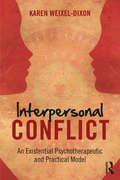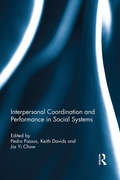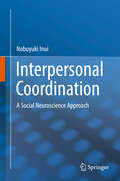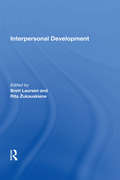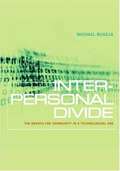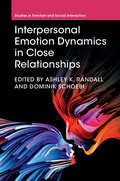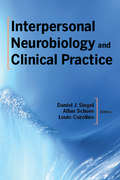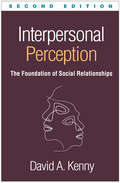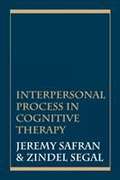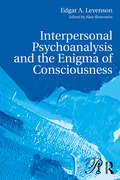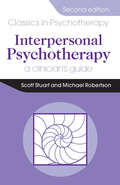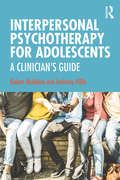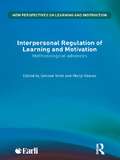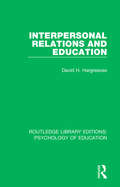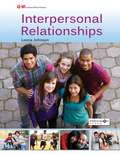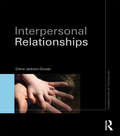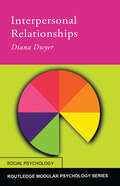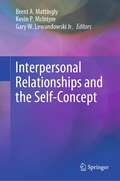- Table View
- List View
Interpersonal Conflict
by Joyce Hocker William WilmotInterpersonal Conflict explains the key dynamics of personal conflicts that we all face. Written for courses such as Communication and Conflict, Interpersonal Conflict, Conflict Management, Conflict and Negotiation, and Conflict in Personal Relationships, this textbook examines the central principles of effective conflict management in a wide variety of contexts--whether at home or on the job. Its combination of up-to-date research and examples gives students a theoretical and practical foundation in conflict management.
Interpersonal Conflict
by William W. Wilmot Joyce L. HockerTextbook examines the central principles of effective conflict management in a wide variety of contexts--from romantic relationships to the workplace. Its combination of up-to-date research and examples gives students a theoretical as well as a practical foundation in conflict management.
Interpersonal Conflict
by William W. Wilmot Joyce L. HockerInterpersonal Conflict explains the key dynamics of personal conflicts that we all face. Written for courses such as Communication and Conflict, Interpersonal Conflict, Conflict Management, Conflict and Negotiation, and Conflict in Personal Relationships, this textbook examines the central principles of effective conflict management in a wide variety of contexts--whether at home or on the job. Its combination of up-to-date research and examples gives students a theoretical and practical foundation in conflict management. Instructors and students can now access their course content through the Connect digital learning platform by purchasing either standalone Connect access or a bundle of print and Connect access. McGraw-Hill Connect® is a subscription-based learning service accessible online through your personal computer or tablet. Choose this option if your instructor will require Connect to be used in the course. Your subscription to Connect includes the following: * SmartBook® - an adaptive digital version of the course textbook that personalizes your reading experience based on how well you are learning the content. * Access to your instructor's homework assignments, quizzes, syllabus, notes, reminders, and other important files for the course. * Progress dashboards that quickly show how you are performing on your assignments and tips for improvement. * The option to purchase (for a small fee) a print version of the book. This binder-ready, loose-leaf version includes free shipping. Complete system requirements to use Connect can be found here: http://www. mheducation. com/highered/platforms/connect/training-support-students. html
Interpersonal Conflict: An Existential Psychotherapeutic and Practical Model
by Karen Weixel DixonInterpersonal Conflict provides a psychotherapeutic and philosophical understanding of the nature of interpersonal conflict. Arguing that facilitating conflict resolution has little to do with objective logic or rationale, and everything to do with personal (and cultural) values and aspirations, Karen Weixel-Dixon uses the lens of existential psychotherapy to provide innovative skills for conflict management. The book offers a deeper understanding of those theories and practices surrounding currently held perspectives on conflict, and extends the repertoire of communication skills relevant to difficult interpersonal situations, offering theoretical and practical input into the possibilities of reaching a therapeutic result. Interpersonal Conflict will be an engaging and informative guide for professionals in psychotherapy, health, HR, legal and teaching professions working with conflict, as well as students taking courses involving conflict resolution.
Interpersonal Coordination and Performance in Social Systems
by Keith Davids Pedro Passos Jia Yi ChowInterpersonal coordination is an important feature of all social systems. From everyday activities to playing sport and participating in the performing arts, human behaviour is constrained by the need to continually interact with others. This book examines how interpersonal coordination tendencies in social systems emerge, across a range of contexts and at different scales, with the aim of helping practitioners to understand collective behaviours and create learning environments to improve performance. Showcasing the latest research from scientists and academics, this collection of studies examines how and why interpersonal coordination is crucial for success in sport and the performing arts. It explains the complex science of interpersonal coordination in relation to a variety of activities including competitive team sports, outdoor sports, racket sports, and martial arts, as well as dance. Divided into four sections, this book offers insight into: the nature, history and key concepts of interpersonal coordination factors that influence interpersonal coordination within social systems interpersonal coordination in competitive and cooperative performance contexts methods, tools and devices for improving performance through interpersonal coordination. This book will provide fascinating insights for students, researchers and educators interested in movement science, performance analysis, sport science and psychology, as well as for those working in the performing arts.
Interpersonal Coordination: A Social Neuroscience Approach
by Nobuyuki InuiThis book explores the fascinating area of interpersonal coordination in force production tasks, outlining the author’s extensive research to date and presenting stimulating new perspectives. The purpose is to provide a detailed exposition of current understanding of the science behind interpersonal joint action. Readers will find clear explanation of concepts from social cognition and neuroscience that are key to an understanding of the field, including the social brain hypothesis, the mirror neuron system, and joint action, as well as other relevant background information. The author then proceeds to present an overview of recent original studies on interpersonal movement coordination performed at his laboratory in Japan. These studies provide insights into such issues as complementary and synchronous force production in joint action, bidirectional transfer between joint and solo actions, and motor control hierarchy in joint action involving bimanual force. They also set the direction for integration of knowledge of physical properties and social cognition. The book will be of interest for researchers and graduate students in all areas of the biomedical sciences.
Interpersonal Development (The\international Library Of Psychology Ser.)
by Rita ZukauskieneThis volume brings together for the first time the papers which have shaped and defined the field of interpersonal development. It celebrates the maturation of the subject by bringing together the best work by scholars who have been instrumental in furthering the field. The twenty-seven essays describe developmental changes in interactions within specific close relationships, covering parent-child relationships, friendships and peer relationships, romantic and spousal relationships, and sibling relationships. They also detail characteristics of specific relationships and interconnections among these key features, as well as tying close relationships to individual outcomes. The essays are accompanied by an introduction which offers a brief history of the field, a review of relationship definitions and a detailed preview of the articles.
Interpersonal Divide: The Search For Community In A Technological Age
by Michael BugejaElectronic communication now keeps us connected, wired, and cabled to the entire world. Why, then, do we often feel displaced and increasingly isolated in the global village? Interpersonal Divide: The Search for Community in a Technological Age seeks to answer the question: have media and technology created a social gap, eroding our sense of community? Author Michael Bugeja tackles this question by taking a broad and interdisciplinary approach, incorporating a number of different viewpoints, including global, ethical, philosophical, corporate, pop cultural, and sociological perspectives. Bugeja analyzes the "interpersonal divide"--the void that develops between people when we spend too much time in virtual rather than in real communities--and makes a case for face-to-face communication in a technological world. He traces media history to show how other generations have coped with similar problems during periods of great technological change, recommending ways to "repatriate to the village." <p><p> Interpersonal Divide, a ground-breaking book, documents how long-standing media theories--including ones by Marshall McLuhan--may no longer hold in the wake of new media and intrusive technology. Bugeja investigates the impact and motives of media ecosystems that have polluted the Internet and other digital devices with marketing ploys, delivering to consumers a global mall rather than a global village. Interpersonal Divide informs readers how to use media and technology wisely so that they enhance rather than replace community.
Interpersonal Emotion Dynamics in Close Relationships (Studies in Emotion and Social Interaction)
by Ashley K. Randall Dominik SchoebiEmotions play a powerful role in close relationships. Significant progress has been made in understanding the temporal features of emotions associated with the development and maintenance of close relationships across the lifespan. This advancement has revealed further questions: which theories help conceptualize interpersonal emotion dynamics? What are the ways researchers can assess and model these dynamics? How do interpersonal emotion dynamics manifest in different close relationships? And do these emotion dynamics contribute to the maintenance or dissolution of relationships? Interpersonal Emotion Dynamics in Close Relationships addresses these and other questions by bringing together state-of-the-art perspectives from scholars widely recognized for their contributions to the study of emotions in relationships. Each chapter defines interpersonal emotion dynamics, reviews methodological or empirical work, and offers important directions for future research. This volume will be a valuable resource for students, researchers, and practitioners interested in understanding the role of emotions in relationships.
Interpersonal Neurobiology and Clinical Practice (Norton Series on Interpersonal Neurobiology #0)
by Louis Cozolino Daniel J. Siegel Allan N. SchoreAn edited collection from some of the most influential writers in mental health. Books in the Norton Series on Interpersonal Neurobiology have collectively sold close to 1 million copies and contributed to a revolution in cutting-edge mental health care. An interpersonal neurobiology of human development enables us to understand that the structure and function of the mind and brain are shaped by experiences, especially those involving emotional relationships. Here, the three series editors have enlisted some of the most widely read IPNB authors to reflect on the impact of IPNB on their clinical practice and offer words of wisdom to the hundreds of thousands of IPNB-informed clinicians around the world. Topics include: Dan Hill on dysregulation and impaired states of consciousness; Deb Dana on the polyvagal perspective; Bonnie Badenoch on therapeutic presence; Kathy Steele on motivational systems in complex trauma.
Interpersonal Perception, Second Edition: The Foundation of Social Relationships
by David A. KennyPeople make judgments about others all the time, often without realizing they are doing so. How are interpersonal impressions formed? How accurate are our perceptions of other people's traits--and our own? In this major revision of his landmark work, David A. Kenny provides a reader-friendly examination of these and other critical questions, identifying key components that shape impressions and their accuracy. Topics include how to estimate perceiver, target, and relationship effects; the extent to which different perceivers see a target in the same way; the impact of group membership and stereotypes; and whether others see us as we see ourselves. Implications for interpersonal relationships and social behavior are highlighted. New to This Edition *Virtually a new book; incorporates 25 years of theoretical, empirical, and methodological advances. *New and greatly expanded topics, including first impressions, individual differences in accuracy, implicit measures, and narcissism. *Grounded in a reformulated conceptual model. *More accessible--uses nontechnical language, humor, popular culture, and simplified figures to elucidate complex ideas. *End-of-chapter "Practical Suggestions" apply the science to real-world social situations.
Interpersonal Process in Cognitive Therapy
by Zindel Segal Jeremy Safran<p>Cognitive therapy, with its clear-cut measurable techniques, has been a welcome innovation in recent years. However, the very specificity that lends itself so well to research and training has minimized the role of the therapeutic relationship, making it difficult for therapists to respond flexibly to different clinical situations. What is needed is an approach that focuses on the underlying mechanisms of therapeutic change, not just on interventions. <p>In this practical and original book, two highly respected clinician-researchers integrate findings from cognitive psychology, infant developmental research, emotion theory, and relational therapy to show how change takes place in the interpersonal context of the therapeutic relationship and involves experiencing the self in new ways, not just altering behavior or cognitions. Making use of extensive clinical transcripts accompanied by moment-to-moment analyses of the change process, the authors illustrate the subtle interaction of cognitive and interpersonal factors. They show how therapy unfolds at three different levels—in fluctuations in the patient's world, in the therapeutic relationship, and in the therapist's inner experience—and provide clear guidelines for when to focus on a particular level. The result is a superb integration of cognitive and interpersonal approaches that will have a major impact on theory and practice.</p>
Interpersonal Process in Therapy: An Integrative Model (5th edition)
by Edward TeyberThis resource for student therapists explains how to use the therapeutic relationship to help clients change. Using a wealth of real life examples including clinical vignettes and therapist-client dialogues, it demonstrates how the interpersonal process approach works. Sample topics include establishing a working alliance with the client, responding to painful feelings, developing a treatment focus, and terminating the therapeutic relationship. Teyber teaches at California State U. , San Bernardino. Annotation ©2005 Book News, Inc. , Portland, OR (booknews. com)
Interpersonal Process in Therapy: An Integrative Model (Seventh Edition)
by Edward Teyber Faith Holmes TeyberInterpersonal Process in Therapy: An Integrative Model, 7th edition, is a clinical training text for those who are seeing clients: graduate student therapists in practicum, internship and other applied practice courses. It is also suitable for advanced students in upper division and pre-practicum courses that provide an in-depth, applied introduction to counseling and therapy.
Interpersonal Psychoanalysis and the Enigma of Consciousness (Psychoanalysis in a New Key Book Series)
by Edgar A. LevensonEdgar A. Levenson is a key figure in the development of interpersonal psychoanalysis whose ideas remain influential. Interpersonal Psychoanalysis and the Enigma of Consciousness builds on his previously published work in his key areas of expertise such as interpersonal psychoanalysis, transference and countertransference, and the philosophy of psychoanalysis, and sets his ideas into contemporary context. Combining a selection of Levenson’s own writings with extensive discussion and analysis of his work by Stern and Slomowitz, it provides an invaluable guide to how his most recent, mature ideas may be understood and applied by contemporary psychoanalysts in their own practice. This book explores how the rational algorithm of psychoanalytic engagement and the mysterious flows of consciousness interact; this has traditionally been thought of as dialectical, an unresolvable duality in psychoanalytic practice. Analysts move back and forth between the two perspectives, rather like a gestalt leap, finding themselves listening either to the "interpersonal" or to the "intrapsychic" in what feels like a self-state leap. But the interpersonal is not in dialectical opposition to the intrapsychic; rather a manifestation of it, a subset. The chapters pick up from the themes explored in The Purloined Self, shifting the emphasis from the interpersonal field to the exploration of the enigma of the flow of consciousness that underlies the therapeutic process. This is not the Freudian Unconscious nor the consciousness of awareness, but the mysterious Jamesian matrix of being. Any effort at influence provokes resistance and refusal by the patient. Permitted a "working space," the patient ultimately cures herself. How that happens is a mystery wrapped up in the greater mystery of unconscious process, which in turn is wrapped into the greatest philosophical and neurological enigma of all—the nature of consciousness. Interpersonal Psychoanalysis and the Enigma of Consciousness will be highly engaging and readable; Levenson’s witty essayist style and original perspective will make it greatly appealing and accessible to undergraduate and postgraduate students of psychoanalysis and psychoanalytic psychotherapy, as well as practitioners in these fields.
Interpersonal Psychoanalysis: A Contemporary Introduction (Routledge Introductions to Contemporary Psychoanalysis)
by Anna Maria LoiaconoIn this book, Anna Maria Loiacono introduces the reader to the origins of Interpersonal Psychoanalysis, its most important concepts, and their clinical value.Throughout the chapters, Loiacono navigates historically through the principles of Harry Stack Sullivan, clearly and succinctly outlining the ideas of those thinkers who followed, to the latest reflections of Contemporary Interpersonal Psychoanalysis. Illustrated with case vignettes, this book addresses concepts such as dissociation, differences between splitting and dissociation, countertransference, enactments, field theory, hermeneutics, the unconscious, the unformulated experience, self-disclosure, relational and interpersonal psychoanalysis, change and the use of the therapist’s subjectivity, as they are currently considered in the interpersonal approach, seen from the perspective of Loiacono’s personal point of view and professional experience.Part of the Routledge Introductions to Contemporary Psychoanalysis series, this book is a vital read for all analysts in practice and training, as well as psychologists and psychiatrists.
Interpersonal Psychotherapy 2E: A Clinician's Guide
by Michael Robertson Scott Stuart'This book provides a very useful and thought-provoking account of a developing form of interpersonal psychotherapy and gives a clear guide for practising clinicians."Psychological MedicineFirst published in 2003, this groundbreaking text firmly established itself as a touchstone for all therapists using interpersonal psychotherapy (IPT). Key featu
Interpersonal Psychotherapy for Adolescents: A Clinician’s Guide
by Robert McAlpine Anthony HillinInterpersonal psychotherapy for adolescents (IPT-A) is a comprehensive guide for clinicians. It will enable readers to add IPT-A to their clinical repertoire or to deepen their existing practice of IPT-A, using a time-limited, evidence-based intervention that is engaging for young people. The guide outlines the structure, skills, and techniques of IPT-A, utilising real-life encounters in the therapy room that reflect the diverse nature of adolescents and young adults who present for therapy. It provides the reader with a bird's-eye view of how IPT-A works. It expands the range of IPT-A clinical tools, techniques, and models to assist the reader to work effectively with a wide range of clients. The book provides a new protocol for the psychological assessment of young people, acknowledging the importance of culture and spirituality alongside the biological, psychological, and social dimensions that have previously comprised assessment. The importance of the clinician forming a transitory attachment relationship with the client is emphasised throughout. The target audience for this book is mental health clinicians, including psychologists, psychiatrists, social workers, mental health nurses, occupational therapists, general practitioners with a mental health focus, and students from these professions.
Interpersonal Regulation of Learning and Motivation: Methodological Advances (New Perspectives on Learning and Instruction)
by Simone Volet Marja VaurasInterpersonal Regulation of Learning and Motivation is the first book in the field to focus on major methodological advances in research on interpersonal regulation of learning and motivation. Interest in developing ways of capturing the dynamics of interpersonal regulation in real-life learning interactions is growing rapidly. Understanding these dynamics is particularly timely given the increased use of collaborative learning activities in schools and university settings, as well as through face-to-face and computer supported collaborative learning (CSCL) environments. While groups and collections of individuals in social interaction are expected to bring their own motivations and goals to the learning situations, it is also assumed that these are further shaped through interaction, as the group activity evolves. Research methodology publications in the field of learning, regulation and motivation are still dominated by a focus on the individual. The study of collaborative learning at both conceptual and methodological level has not incorporated the significance of social regulatory processes of learning and motivation. This is a new development in the field and one covered by this book. The book contains numerous illustrations of innovative: Methodological approaches to study and interpret the dynamics of interpersonal regulation Data sources and data representations to capture scaffolded instruction Theory-based analytic methods to investigate interactions in real-life collaborative learning Coding systems and social software tools for gathering and analysing interactive data. Interpersonal Regulation of Learning and Motivation brings together the work of scholars who have been studying interpersonal regulation of learning and motivation at the boundaries of the individual and the social, and who have made original methodological contributions to the study of interactive learning environments. In combination, their work provides a range of distinctive and original conceptual and methodological contributions to this under-examined and vital field of research, making this an essential read for any researcher or student interested in collaborative learning and motivation.
Interpersonal Relations and Education (Routledge Library Editions: Psychology of Education)
by David H. HargreavesOriginally published in 1972, this title provides an analysis of social interactions in educational contexts and opens up the field of the social psychology of education as an area in its own right at the very heart of the process of education. From a ‘symbolic interactionist’ perspective, the author develops a framework for the study of relations between teachers and pupils, discussing the basic ways of analysing social interaction, including the concepts of perception and role. He examines the distinctive perspectives of teachers and pupils on their relationships, bringing together into a coherent framework the insights of such writers as John Holt and Carl Rogers, and within this context he explores the notion of ‘voluntary schooling’. The book also deals with other important aspects of education such as discipline, classroom group dynamics and the relations between headteachers and their staff. The theories put forward by the author are firmly grounded in the daily experience of teachers and pupils in the classroom at the time. The book was expected to be of value to experienced teachers and student teachers alike, as well as to teachers of the social sciences in general.
Interpersonal Relationships (Foundations of Psychology)
by Diana Jackson-DwyerWith a more specific focus than the all-encompassing textbook, each title in the Foundations of Psychology series enables students who are new to psychology to get to grips with a key area of psychological research, while also developing an understanding of basic concepts, debates, and research methodologies. In this book Diana Jackson-Dwyer presents an introductory survey of classic and recent research on relationships and the theories that underpin them. The book starts with a brief overview of the place of relationships within the history of psychology and of their evolutionary roots: our need to belong, to attach and to affiliate. After a look at methodology, it considers different types of relationships: kinship, friendship, loving and mating. Theories are advanced to explain the formation, maintenance and breakdown of relationships. The book draws on a wide array of contemporary research, and covers issues ranging from rising divorce rates to cultural variations in mating patterns, the issue of gay marriage, and the effect of the internet on relationships. Each chapter contains numerous pedagogical features which will help students to engage with the material: Chapter-specific learning objectives and summaries of key points Study boxes presenting reflective exercises, research questions, and issues for discussion Glossaries and suggestions for further reading Assuming no prior knowledge of the subject, Interpersonal Relationships provides an accessible and up-to-date overview of this vibrant area of psychology. The book will be ideal reading for students who are new to higher-level study - whether at school, college or university, and will also be useful for first-year undergraduate students taking introductory courses in psychology.
Interpersonal Relationships (Routledge Modular Psychology)
by Diana DwyerInterpersonal Relationships considers friendship and more intimate relationships including theories of why we need them, how they are formed, what we get out of them and the stages through which they go. Social and cultural variations are discussed as well as the effects of relationships on our well-being and happiness.The book is tailor-made for the student new to higher-level study. With its helpful textbook features provided to assist in examination and learning techniques, it should interest all introductory psychology and sociology students, as well as those training for the caring services, such as nurses.
Interpersonal Relationships and the Self-Concept
by Gary W. Lewandowski Brent A. Mattingly Kevin P. McIntyreThis volume provides an overview of the theoretical and empirical work on relationship-induced self-concept change that has occurred over the last 10-15 years. The chapters in this volume discuss the foundations of relationship self-change, how and when it occurs, how it influences relationship decisions and behavior, and how it informs and modifies subsequent knowledge structures, all examined over the course of the relationship cycle (i.e., initiation, maintenance, and dissolution). Additionally, this volume identifies novel applications and extensions of the relationship self-change literature, including applications to health and behavior, intergroup relations, and the workplace. Among the topics discussed: Self-disclosure in the acquaintance processCommitment readinessBolstering attachment security through close relationshipsSelf-concept clarity and self-changeThe role of social support in promoting self-developmentRelationship dissolution and self-concept changeIntergroup and sociocultural factors of self-expansionSelf-concept change at workMeasurement of relationship-induced self-concept change Interpersonal Relationships and the Self-Concept serves both as a comprehensive overview of the existing empirical research as well as a roadmap for future research on self-change, including a discussion of emerging theoretical frameworks. It will interest researchers focusing on romantic relationships, self and identity, and the intersection of self and relationships, spanning the disciplines of psychology, sociology, communication, and family studies.
Interpersonal Relationships: Professional Communication Skills for Nurses
by Kathleen Underman Boggs Elizabeth C. ArnoldAcclaimed for its strong theoretical framework and consistent organization, Arnold and Boggs' Interpersonal Relationships: Professional Communication Skills for Nurses, 6th Edition, remains the definitive resource in developing effective communication with clients, families, and colleagues in order to achieve treatment goals in health care. This two-time AJN Book of the Year award-winner is thoroughly updated and includes current references describing how to modify communications strategies for various populations and situations including children, the elderly, end of life, health teaching, stress, crisis, and colleagues. Two new chapters address issues in contemporary health care related to promoting health safety and supporting continuity of care. Not only does this book present proven communications strategies and principles in nursing, psychology, and related theoretical frameworks, but also it challenges you to apply these strategies and principles to numerous exercises and practical nursing case studies. Written in terms of the nurse-client relationship, the cutting-edge communications strategies presented are key for nursing students and professional nurses. Covers all mandated topics for nursing professionals, from beginning students to staff development in a variety of settings, including professional collaboration, health team communication, patient-centered care, safety, and hand-off communication. Discusses nursing, behavioral, developmental, family, and communication theories, providing an essential foundation and a theoretical perspective of effective communication. Offers basic concepts first, followed by applications with emphasis on assessment, providing a sound framework as you prepare for nurse-client interactions. Experiential exercises offer the opportunity to practice, observe and critically evaluate your professional communication skills in a safe learning environment. Critical Thinking Exercises promote critical thinking processes essential for effective communication in nursing practice. Includes case examples throughout, creating empathy for clients' perspectives and needs. Offers Ethical Dilemma and Developing an Evidence-Based Practice boxes in each chapter. Describes how best to use the electronic health record for clear communication with current information on classification systems, standards of documentation, and telehealth technologies used in nursing. Acknowledges humor, gender, and touch as important means of communication in interpersonal relationships. Increases awareness of the issues involved in communicating with individuals of various stages of life, clients with special needs, and colleagues in all areas of health care. Provides learning objectives, chapter overviews, and a detailed glossary -- all designed to focus your learning and help you organize key content. A timely NEW Communicating for a Safe Environment chapter provides practice guidelines in line with The Joint Commission National Patient Safety Goals on improved communication among caregivers. NEW Communicating for Continuity of Care chapter defines COC and describes current challenges, and addresses its relational, informational, and management dimensions. Enhanced discussion on spirituality and end-of-life needs focuses on trust, empathy, and the nurse-client relationship -- all central components of holistic nursing identified by The Joint Commission as priorities for patient care.



